Friday, 7 October, Würzburg, Germany
Written 9 March 20232
We were still cruising at breakfast time, so our shore excursion didn't start until 9:45 am, shortly after we moored at Würzburg. "Gewürze" is german for "spice" or "seasoning"; Würzburg used to be big in the spice trade.
Folks who spent time out on the open-air Aquavit Terrace in the bow, told us at breakfast that the previous afternoon, we had been buzzed by drones controlled by kids on one of the bridges we passed under. And early this morning, the crew set up a litre water bottle, a half-liter water bottle, and a miniature Tabasco bottle on the front edge of the wheelhouse roof. One bridge we passed under during breakfast knocked over the litre bottle! We heard the cheer inside but I didn't realize what it was about. The next bridge cleared the litre bottle by about a quarter-inch.

 After breakfast (which included these warm, tasty, flaky little quichey things), as I suited up for our walking tour, the bow cam showed a whole fleet of buses pulling up outside the ship. Once again, we were signed up for the leisurely tour. Our guide was Elinor, but I didn't catch the driver's name.
After breakfast (which included these warm, tasty, flaky little quichey things), as I suited up for our walking tour, the bow cam showed a whole fleet of buses pulling up outside the ship. Once again, we were signed up for the leisurely tour. Our guide was Elinor, but I didn't catch the driver's name.
About the first thing Elinor told us was that because of the damage during the WWII bombing, not many original facades remain. The tower in the right-hand photo is (I think) the brick church that is no longer a church—it's part of the university and is used as the hall for graduation ceremonies and rehearsals. The city's population is about 78,000, a figure that includes about 35,000 students.
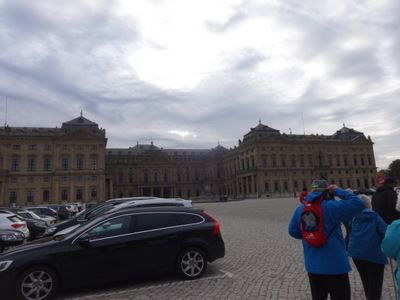
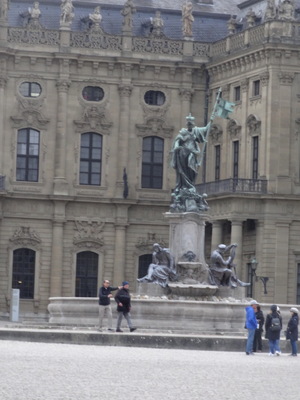 First stop on our tour was the Prince Bishop's Residence, the one commissioned by Prince-Bishop Johann Philipp Franz von Schönborn and his brother Friedrich Carl von Schönborn in 1720. They hired an unknown young architect named Balthazar Neumann and then brought in an amazing assortment of talent to finish and decorate the place, which took 22 years (10 years for the interior alone).
First stop on our tour was the Prince Bishop's Residence, the one commissioned by Prince-Bishop Johann Philipp Franz von Schönborn and his brother Friedrich Carl von Schönborn in 1720. They hired an unknown young architect named Balthazar Neumann and then brought in an amazing assortment of talent to finish and decorate the place, which took 22 years (10 years for the interior alone).
To give us an idea of the size of the place, which you can't really see all of from the front, Elinor told us that it was about equal in square footage to that of its parking lot—that is, big. It has 360 rooms; as she said, could sleep in a different room every night for a year. Unfortunately, because it was solid stone, it was pretty cold and uncomfortable to live in. It was also the only venue we visited where we were required to wear masks.
Centered in front of it is this fountain, much more recent that the residence itselfof the artiest; a figure representing Franconia stands on top. Around the base are three celebrated artists of the region: Walther von der Vogelweide (a lyric poet), Tilman Riemenschneider (a sculptor and woodcarver), and Matthias Grünewald (a painter).
Unfortunately, no photos were allowed inside. Drat. 'Cause it was magnificent! No crummy "porte cochère" canopy here: horsedrawn carriages were driven directly into the entrance hall, then made a turn to stop in front of the stairs. The ceiling of the entrance hall itself was not very decorative or colorful, but that over the double grand staircase took my breath away. It's by Giovanni Battista Tiepolo and his sons, brought in from Venice for the job, and it's the largest ceiling fresco in the world (they completed it in a year).
In the center is Apollo, surrounded by other scenes from mythology. Around the sides are groupings representing allegories of the four continents then recognized. Lady America is wearing Indian features and riding an alligator; her surroundings are shown as very barbaric and wild (even though Harvard and Yale were already in operation at the time). Lady Africa is riding a dromedary; her surroundings are pretty barbaric but more civilized than America. They include representations of the incense and ivory trade. Old man with a white beard and blue draperies holding a paddle represents the Nile. Lady Asia is riding an elephant, which looks rather strange; Tiepolo had never seen ostriches or elephants. She wears fine silk clothes and seems very civilized. An obelisk represents architecture. The Armenian alphabet engraved on a stone represents language, a proof of culture and cultivation. Three crosses stand on a hill, representing at Calvary.
Lady Europe sits on a throne, rather than riding an animal. Above her, Prince-Bishop Karl Philipp von Greiffenclau (who commissioned the painting) is portrayed in a frame held up by angels. (All the other ladies are pointing toward it.) Musicians represent culture.
Scattered here and there are other fun details: Tiepolo himself is there, with a son looking over his shoulder. Neumann, the architect, wears a purple uniform (he was in the military) and is sitting on a cannon; he also used to cast cannons and bells. Antonio Bossi, the residence's stucco artist, wearsa beige cape; his eyes supposedly follow you around the room. The allegory of painting appears to the left of Lady Europe, represented as a painter pointing to Wurzburg.
When the residence was built, nobody believed that that huge, wide vault over the stairs would hold, but Neumann apparently knew what he was doing.
But that fresco is not all the place has to offer. Other rooms had very elaborate monochrome ceilings in plaster relief and filigree and even 3D plaster figures sticking their feet out from the surface. Bossi did all the filigree stucco work in the white hall, free hand. Empress Maria Theresa was due for a visit, and he worked day and night to finish the white hall in time. When she arrived, though, she rushed right through it without looking and went straight to bed. Bossi developed "nerve fever" from overwork and went insane.
The white hall also has a magnificent big black stove with gilded cherubs, which was stoked from the back, from inside the wall.
The imperial hall combines Neumann, Tiepolo, and Bossi, decorated in white, gold, faux marble. A painting shows Emperor Frederick I (Barbarossa) marrying Beatrice of Burgundy. Fred had a time finding a bishop who would marry him a second time (he'd had his first, childless, marriage annulled on the grounds of consanguinity—he and Adelaide were fourth cousins once removed), but he found one in Wüzburg. The couple are wearing 15th century clothes rather than 12th because Tiepolo wanted it to look more modern. The crucifix is behind a curtain (only Jesus's feet show), because the marriage was so iffy. Finally, the bishop protrayed in the painting is the current one at he time it was painted and not the one from earlier, when the wedding took place. A different paining protrays the investiture of the bishop; the bishop kneels in front of the emperor, just the opposite of the wedding painting.
In the imperial hall, some of the marble is real (the columns, I think), but the rest is faux marble, which (the guide assured us) would be more expensive than just using the real stuff.
The glass chandeliers were transported embedded in grease or butter (Elinor added that in German, if everying is going well, you way that everything is in butter).
Then we were shown a whole succession of rooms decorated in a wide variety of styles. One was lined with tapestries of asian warfare. Another was in ancient Greek style and featured a big grandfather clock. Another was ref flocked (probably silk) wallpaper. The green damask room had a very ornately framed mirror. The Napoleon room was the one where he slept 13–14 May 1812. Room 19 was called the "souper room"; perhaps they meant "supper room" ("souper" is French for "supper"). Number 20, the "tea room," was all pink upholstery and gilded stucco. The guide apologized for the green lacquered room; apparently, bombinb damage ruined much of the shimmery quailty of green lacquer over silver, but it's been preserved in a few spots. Another room had a radially-arranged parquet floor with a rosette in the center and housed Veronese paintings of 14 different sultans wearing different turbans.
Other notable works we were shown were paintings of St. Sebastian by Il Giovane and of the stoning of St. Stephan by Tiepolo, as well as tapestries of Alexander the Great by Jan Franz van der Hecke, around 1700.
The residence was badly damaged during WWII. (We were told that 20 minutes of bombing destroyed 90% of the town. It contained no military objective, but the weather here happened to be good that day.) In 1945, an American art protection officer named John Davis Skilton arrived in Würzburg and fell in love with it. He organized the initial rescue and reconstruction, and at the time he managed the almost impossible—he got hold of enough lumber, tar paper, and cement to build temperary shelters over the vaults and saved Tiepolo's fresco and the imperial hall. Not only did Neumann's vault hold it's own weight, but it stood even when bombs brought the roof above down on top of it. Restorers did a few repairs of water stains from fighting the fires, but everything else is original. Today the place is a UNESCO World Heritage site, though the final proper roof over the princes's hall was only completed in 1973.

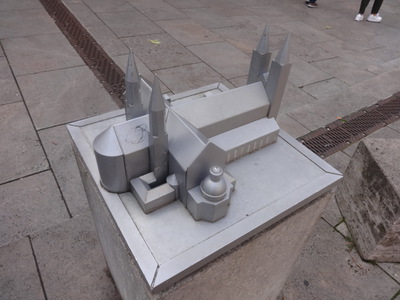 From the residence, we moved back into the middle of town. The building at the left is the current bishop's residence; rather more modest, but still handsome.
From the residence, we moved back into the middle of town. The building at the left is the current bishop's residence; rather more modest, but still handsome.
At the right is the usual model of the cathedral, but it's a more modern cathedral, and a more modern model. I didn't ask what it's made of, but clearly not the usual bronze, and it doesn't include all the fiddly detail you usually see.
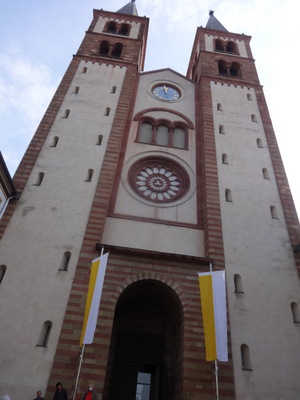
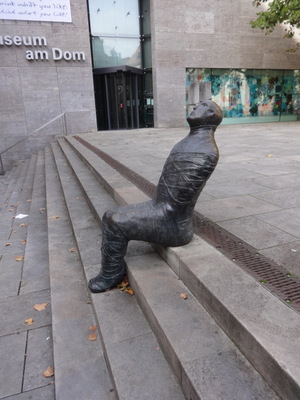 As you can see from this image of the cathedral itself, it doesn't actually have all that fiddly detail to protray.
As you can see from this image of the cathedral itself, it doesn't actually have all that fiddly detail to protray.
At the right is a work of art (presumably bronze) sitting on the steps outside the cathedral (with the cathedral museum in the background). Our guide said that, according to the artist, "it doesn't mean anything." That's art for you.
The cathedral is dedicated to, of all people, St. Killian, an Irish missionary who came here in the 7th century with two Irish monks to try to convert the town to Christianity and got murdered (i.e., martyred) for his trouble. He is now, for some reason, the patron saint of the town. He and the monks are buried under the cathedral.
The cathedral is Catholic, but there are some protestant churches in town as well.
Würzburg has at least two universities (maybe three). One has "normal" subjects like math, medicine, and languages, but there's another for, e.g., applied sciences and visual communication. The university for music is in yellow building across from the residence. In this part of the world, most universitis don't have campuses; they're housed in buildings scattered around town.
Someone asked about education, so the guide said it starts with four years of primary school. Eventually, your grades determine where you go next—"gymnasium" (college prep high school) or other schools that are slower. If you can't get into gymnasium initially, you can get a sort of GED while you're working and get in that way. After high school, you can choose between university of an apprenticeship. Universities have entrance exams.
Something I apparently didn't get a photo of is the Chronos fountain. Chronos stands on top and points to the residence. Cleo the muse sits next to him to write down the story of the residence. Eos is on the pedestal; he's the god of this river, the Main. He wears a belt of grapes, because this area grows a lot of vineyards. This was one of the first fountains in town with clean drinking water, being spring-fed, but it's no longer potable today.

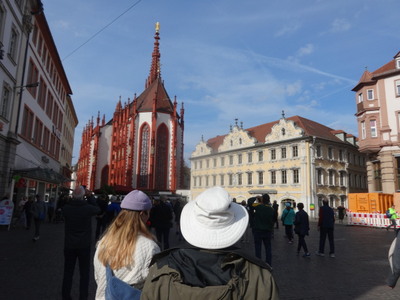 At the left here is the flamboyantly baroque façade of the Neumünster Collegiate (Catholic) Church. It says "Joannus Philippus Episcopus" over the door, so presumably a Bishop Joannus Philippus built it.
At the left here is the flamboyantly baroque façade of the Neumünster Collegiate (Catholic) Church. It says "Joannus Philippus Episcopus" over the door, so presumably a Bishop Joannus Philippus built it.
At the right is the 14th century Marienkapelle, St. Mary's chapel. Despite its size, it's only a chapel because it doesn't have a parish. It was Neumann's church, so he's buried there.

 We didn't go in, but we stopped to view this amazing relief over the door. It's the annunciation scene, but it's not clear why the angel is even there, as God is speaking through a tube directly into Mary's ear. The dove of the holy spirit is right next to her, and although this image may be too small to show it, a tiny baby boy is sliding, head first, arms stretched before him, down the outside of the tube toward her!
We didn't go in, but we stopped to view this amazing relief over the door. It's the annunciation scene, but it's not clear why the angel is even there, as God is speaking through a tube directly into Mary's ear. The dove of the holy spirit is right next to her, and although this image may be too small to show it, a tiny baby boy is sliding, head first, arms stretched before him, down the outside of the tube toward her!
The area of the cathedral (and all these other churches) is also "shopping central," both for weekly open markets and for brick-and-mortar shops.
The market stall at the right is featuring "Federweisser," new wine. It's the still-fermenting juice squeezed from the recent harvest, only available for a short time in the fall. It's very sweet, because the yeast haven't yet used up the sugar. Eighty percent of the grapes grown around here are used to produce white wines (Elinor mentioned Silvaner and a couple of varieties I didn't catch), but the Federweisser seems to come in both white and pink.
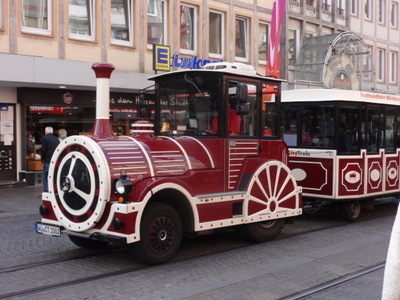
 At the left here is the local tourist train (almost always white in France but much more colorful in Germany). Elinor said that in the early weeks and months of the school year, schools have "wundertags," days of wonder, when the kids are taken out on field trips to museums and other cultural attractions. It was definitely the season, as we encountered many school groups during our walk.
At the left here is the local tourist train (almost always white in France but much more colorful in Germany). Elinor said that in the early weeks and months of the school year, schools have "wundertags," days of wonder, when the kids are taken out on field trips to museums and other cultural attractions. It was definitely the season, as we encountered many school groups during our walk.
In a particularly nice little shopping street she pointed out, I spotted this shop selling all sorts of sandwiches, some on kaiser rolls and some on pretzel bread.

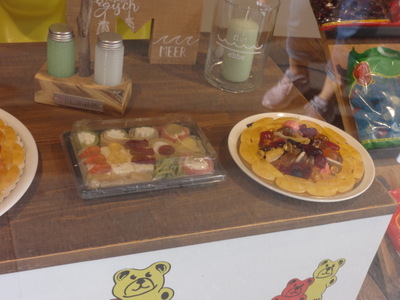 To go with them, it was selling yummy-looking pastries.
To go with them, it was selling yummy-looking pastries.
And nearby was a store that specialized narrowly in gummy bears. But not just bears. As you an see in the photo, you could also by trays of gummy glacé fruit and square boxes of gummy sushi! I have no idea whether they gummies were actually, e.g., shrimp or wasabi flavored.
No chains are allowed here, only local stores.
I didn't get a good photo of it, but the "House of the Falcon, used to be a tavern. The owner asked for, and was granted, tax relief in exchange for beautifying the city by adding a rococo facade. She was therefore able to build in lots of windows without paying tax on them. I think we heard that the house is now the public library.
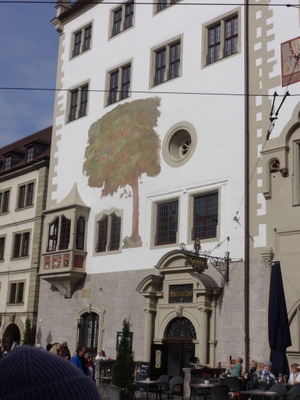
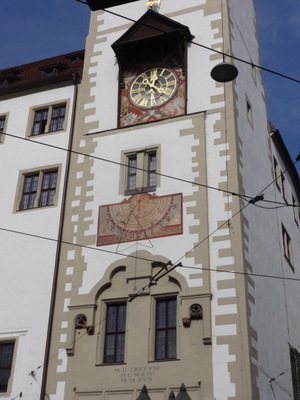 At the left is the Rathaus, the town hall. Apparently, the city council originally met under a particular tree in town, so the tree is painted on the new building, still sheltering their deliberations.
At the left is the Rathaus, the town hall. Apparently, the city council originally met under a particular tree in town, so the tree is painted on the new building, still sheltering their deliberations.
To the right of the tree, the building's tower is equipped with both a clock for cloudy days and a back-up sundial for mechanical failures.
This was the first Rathaus I've come across that had an actual Ratskellar under it!
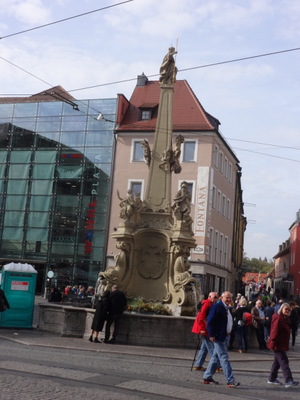
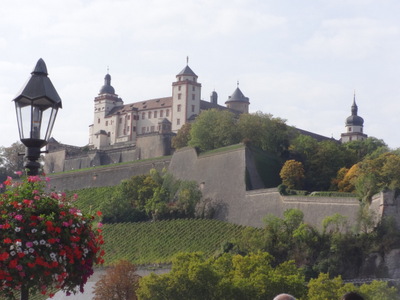 Nearby is another fountain, with spouting dolphins, that is the best known fountain of the city. Once again Franconia stands on top, but this time this time facing the Rathaus. The four virtues adorn the sides.
Nearby is another fountain, with spouting dolphins, that is the best known fountain of the city. Once again Franconia stands on top, but this time this time facing the Rathaus. The four virtues adorn the sides.
When the bishop built this fountain, the people didn't believe it was clean drinking water, so the bishop arranged for it to spout wine for a few days, and that brought them around.
I think the photo at the right is of the fortress where the prince bishops lived before they moved down to the ornate residence we visited.

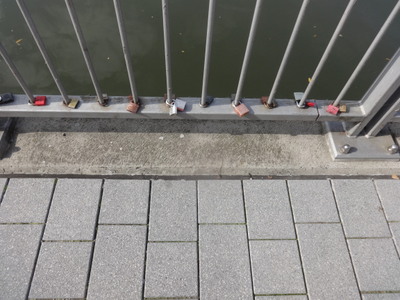 On the way back to the ship, we stopped off at the old Main bridge, how limited to pedestrian traffic. It has become traditional to meet your friends here and drink a glass of wine with them on the bridge. A shop conveniently sells glasses of wine right next to it.
On the way back to the ship, we stopped off at the old Main bridge, how limited to pedestrian traffic. It has become traditional to meet your friends here and drink a glass of wine with them on the bridge. A shop conveniently sells glasses of wine right next to it.
And as the photo at the right shows, this the where the local couples of padlock enthusiasts come to attach their locks. The local powers that be come by regularly with bolt cutters, so they don't build up too badly.
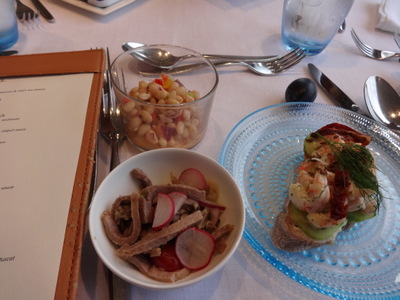
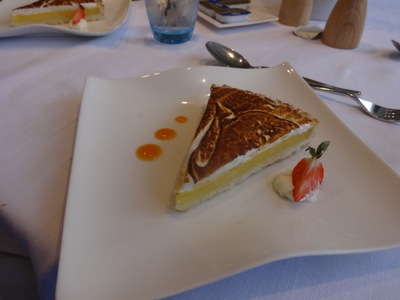 The fine-print appetizers at lunch were particularly good: A salad of vinaigrette-dressed white beans, a dish of strips of left-over beef with radishes, and an open-face shrimp sandwich, with sundried tomatoes, I think. The green under the shrimp was not avocado, as I feared at first sight, but slices of cucumber.
The fine-print appetizers at lunch were particularly good: A salad of vinaigrette-dressed white beans, a dish of strips of left-over beef with radishes, and an open-face shrimp sandwich, with sundried tomatoes, I think. The green under the shrimp was not avocado, as I feared at first sight, but slices of cucumber.
For the main course, I think I had the shell pasta with mushrooms, tomatoes, peas, and (as usual), not enough cream.
One of the dessert choices was "chocolate chip sundae, which initially sounded promising, but it was described as chocolate ice cream with chocolate-chip cookies crumbled over it, topped with chocolate sauce and whipped cream, so I went for the lemon meringue tart instead.
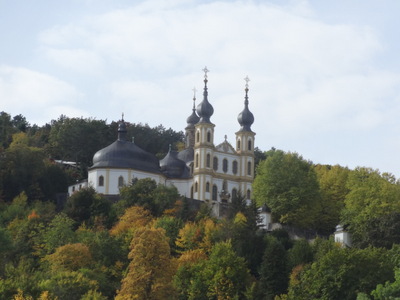 Across the river, we had a view of this lovely little chapel. At some point in its history, it had been turned so that its façade faced the town, putting its altar at the "wrong" end. It's a pilgrimage church, so you have the option on climbing the many, many steps up to it (on your knees if you prefer) praying at each step.
Across the river, we had a view of this lovely little chapel. At some point in its history, it had been turned so that its façade faced the town, putting its altar at the "wrong" end. It's a pilgrimage church, so you have the option on climbing the many, many steps up to it (on your knees if you prefer) praying at each step.
We had no excursion planned for the afternoon. We had already skipped the full-day trip to Rothenburg ob der Tauber, and the only other option was "Hike the Würzburg Hills," which was not to our taste. So again, we enjoyed a leisurely afternoon aboard. David read, and I worked on this diary. Some people walked back into town to shop, but that's not really our thing either.
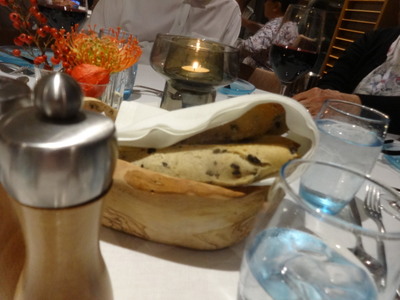
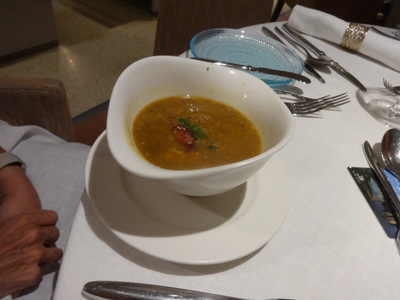 For dinner, we had those nice rolls of chewy olive bread again. Very good.
For dinner, we had those nice rolls of chewy olive bread again. Very good.
The soup was lentil with smoked sausage. That was Jan's choice I think

 The regional-specialty appetizer was "obadzta," Bavarian cheese dip served on top of a fat little round pretzel (almost more like a bagel) with radishes and marinated red onion. Not bad, but not terrific either.
The regional-specialty appetizer was "obadzta," Bavarian cheese dip served on top of a fat little round pretzel (almost more like a bagel) with radishes and marinated red onion. Not bad, but not terrific either.
The main course, also regional specialty, was "crispy roast pork with beer sauce and creamy savoy cabbage." The pork and the creamy cabbage (entirely hidden under the pork) were both outstanding, and the slices of bread dumpling were pretty good, but the square of supposedly crispy skin (the brown rectangle on top of the pork) was dreadful. It was basically shoe leather deep fried to petrefaction. You could break your teeth. Now on our last Viking cruise, at the German dinner, we were served crispy roast pork knuckle on which the skin was crackling crisp but tender as a potato chip, so it can be done (and I have even done it myself, following the recipe I asked for on that occasion). This chef needs lessons in crisping pork skin.

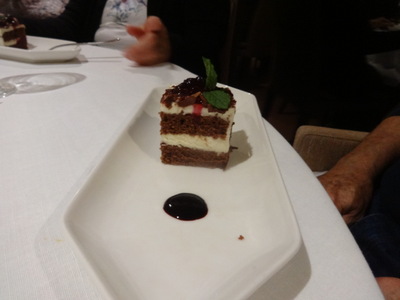 The regional-speciality dessert was apricot crumble, but I think Ron, sitting to my right got the better choice—black forest cake.
The regional-speciality dessert was apricot crumble, but I think Ron, sitting to my right got the better choice—black forest cake.
The ship cast off as we sat down to eat.

 After dinner, the evening's entertainment was a glass-blowing demonstration by a 7th-generation glassblower from Wertheim (tomorrow's destination).
After dinner, the evening's entertainment was a glass-blowing demonstration by a 7th-generation glassblower from Wertheim (tomorrow's destination).
Wertheim is apparently famous for glass. Corning makes borosilicate glass—Pyrex— there.
Hans the glassblower clearly could not bring aboard one of those huge, frightenly hot ovens where glass is melted to the liquid state so that you can stick a long pipe into it and blow vases and whatnot. (That's what it takes to make things like the big blue bowl with the red rim on the left side of his cart.) Instead, he demonstrated "lamp work," starting with ready-made glass tubes, heating them over a sort of souped up Bunsen burner, and stretching, twisting, and blowing them into shapes. That's how shopping-mall glass blowers make all those little animals and ballerinas. And here in Germany, it's how they make the beautiful hollow glass Chistmas ornaments they sell in the Christmas markets.
He started by demonstrating the very first steps in a glass-blower's education. Pulling glass tubes into ampules with long beaks on them, closed at the end (vaccine ampules are made that way). Then they learn how to make "blanks," little glass tear-drop shapes that can be blown into
perfect 1" balls on stems.
Beginners and the ill-trained used to make money producing glass thermometers, but Hans says the advent of the digital thermometer has kill off that option.
Another bread-and-butter craft for a glass-blower is Christmas ornaments; they don't have to be all the same size or even shape. The hardest part is twisting the glass stem into the tiny loop to form the hanger. Just be careful, his father warned him, not to blow it too big to fit in the little cardboard box you'll hand (or ship) it to the customer in!
Here in Wertheim, in his youth, he started the trend toward letting childen blow their own ornaments, right there on the spot in the Christmas market. He's now been doing it for years, and others have taken up the idea.
But he's also a serious glass craftsman. He's spent 20 summers at Pilchuck (in Washington state) learning the Chihuly style, and we were all invited to visit his shop the next day to shop not just for the little ornaments but for paperweights and larger items like the blue bowl. We ship, he said, all over the world.
Previous entry
List of Entries
Next entry

 After breakfast (which included these warm, tasty, flaky little quichey things), as I suited up for our walking tour, the bow cam showed a whole fleet of buses pulling up outside the ship. Once again, we were signed up for the leisurely tour. Our guide was Elinor, but I didn't catch the driver's name.
After breakfast (which included these warm, tasty, flaky little quichey things), as I suited up for our walking tour, the bow cam showed a whole fleet of buses pulling up outside the ship. Once again, we were signed up for the leisurely tour. Our guide was Elinor, but I didn't catch the driver's name.

 First stop on our tour was the Prince Bishop's Residence, the one commissioned by Prince-Bishop Johann Philipp Franz von Schönborn and his brother Friedrich Carl von Schönborn in 1720. They hired an unknown young architect named Balthazar Neumann and then brought in an amazing assortment of talent to finish and decorate the place, which took 22 years (10 years for the interior alone).
First stop on our tour was the Prince Bishop's Residence, the one commissioned by Prince-Bishop Johann Philipp Franz von Schönborn and his brother Friedrich Carl von Schönborn in 1720. They hired an unknown young architect named Balthazar Neumann and then brought in an amazing assortment of talent to finish and decorate the place, which took 22 years (10 years for the interior alone).
 From the residence, we moved back into the middle of town. The building at the left is the current bishop's residence; rather more modest, but still handsome.
From the residence, we moved back into the middle of town. The building at the left is the current bishop's residence; rather more modest, but still handsome.
 As you can see from this image of the cathedral itself, it doesn't actually have all that fiddly detail to protray.
As you can see from this image of the cathedral itself, it doesn't actually have all that fiddly detail to protray.
 At the left here is the flamboyantly baroque façade of the Neumünster Collegiate (Catholic) Church. It says "Joannus Philippus Episcopus" over the door, so presumably a Bishop Joannus Philippus built it.
At the left here is the flamboyantly baroque façade of the Neumünster Collegiate (Catholic) Church. It says "Joannus Philippus Episcopus" over the door, so presumably a Bishop Joannus Philippus built it.
 We didn't go in, but we stopped to view this amazing relief over the door. It's the annunciation scene, but it's not clear why the angel is even there, as God is speaking through a tube directly into Mary's ear. The dove of the holy spirit is right next to her, and although this image may be too small to show it, a tiny baby boy is sliding, head first, arms stretched before him, down the outside of the tube toward her!
We didn't go in, but we stopped to view this amazing relief over the door. It's the annunciation scene, but it's not clear why the angel is even there, as God is speaking through a tube directly into Mary's ear. The dove of the holy spirit is right next to her, and although this image may be too small to show it, a tiny baby boy is sliding, head first, arms stretched before him, down the outside of the tube toward her! 
 At the left here is the local tourist train (almost always white in France but much more colorful in Germany). Elinor said that in the early weeks and months of the school year, schools have "wundertags," days of wonder, when the kids are taken out on field trips to museums and other cultural attractions. It was definitely the season, as we encountered many school groups during our walk.
At the left here is the local tourist train (almost always white in France but much more colorful in Germany). Elinor said that in the early weeks and months of the school year, schools have "wundertags," days of wonder, when the kids are taken out on field trips to museums and other cultural attractions. It was definitely the season, as we encountered many school groups during our walk.
 To go with them, it was selling yummy-looking pastries.
To go with them, it was selling yummy-looking pastries.
 At the left is the Rathaus, the town hall. Apparently, the city council originally met under a particular tree in town, so the tree is painted on the new building, still sheltering their deliberations.
At the left is the Rathaus, the town hall. Apparently, the city council originally met under a particular tree in town, so the tree is painted on the new building, still sheltering their deliberations.

 Nearby is another fountain, with spouting dolphins, that is the best known fountain of the city. Once again Franconia stands on top, but this time this time facing the Rathaus. The four virtues adorn the sides.
Nearby is another fountain, with spouting dolphins, that is the best known fountain of the city. Once again Franconia stands on top, but this time this time facing the Rathaus. The four virtues adorn the sides. 
 On the way back to the ship, we stopped off at the old Main bridge, how limited to pedestrian traffic. It has become traditional to meet your friends here and drink a glass of wine with them on the bridge. A shop conveniently sells glasses of wine right next to it.
On the way back to the ship, we stopped off at the old Main bridge, how limited to pedestrian traffic. It has become traditional to meet your friends here and drink a glass of wine with them on the bridge. A shop conveniently sells glasses of wine right next to it.

 The fine-print appetizers at lunch were particularly good: A salad of vinaigrette-dressed white beans, a dish of strips of left-over beef with radishes, and an open-face shrimp sandwich, with sundried tomatoes, I think. The green under the shrimp was not avocado, as I feared at first sight, but slices of cucumber.
The fine-print appetizers at lunch were particularly good: A salad of vinaigrette-dressed white beans, a dish of strips of left-over beef with radishes, and an open-face shrimp sandwich, with sundried tomatoes, I think. The green under the shrimp was not avocado, as I feared at first sight, but slices of cucumber. Across the river, we had a view of this lovely little chapel. At some point in its history, it had been turned so that its façade faced the town, putting its altar at the "wrong" end. It's a pilgrimage church, so you have the option on climbing the many, many steps up to it (on your knees if you prefer) praying at each step.
Across the river, we had a view of this lovely little chapel. At some point in its history, it had been turned so that its façade faced the town, putting its altar at the "wrong" end. It's a pilgrimage church, so you have the option on climbing the many, many steps up to it (on your knees if you prefer) praying at each step.
 For dinner, we had those nice rolls of chewy olive bread again. Very good.
For dinner, we had those nice rolls of chewy olive bread again. Very good.
 The regional-specialty appetizer was "obadzta," Bavarian cheese dip served on top of a fat little round pretzel (almost more like a bagel) with radishes and marinated red onion. Not bad, but not terrific either.
The regional-specialty appetizer was "obadzta," Bavarian cheese dip served on top of a fat little round pretzel (almost more like a bagel) with radishes and marinated red onion. Not bad, but not terrific either. The regional-speciality dessert was apricot crumble, but I think Ron, sitting to my right got the better choice—black forest cake.
The regional-speciality dessert was apricot crumble, but I think Ron, sitting to my right got the better choice—black forest cake.
 After dinner, the evening's entertainment was a glass-blowing demonstration by a 7th-generation glassblower from Wertheim (tomorrow's destination).
After dinner, the evening's entertainment was a glass-blowing demonstration by a 7th-generation glassblower from Wertheim (tomorrow's destination).